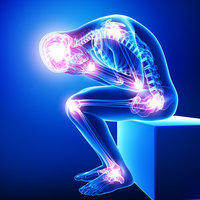
male all joints pain in blue
A new federal report revealed that the majority of U.S. adults (more than 54 percent) had some type of musculoskeletal pain disorder such as back, joint or neck pain in 2012 (the latest year for which statistics are available).
Its prevalence is indicative of the significant price Americans pay for pain — it’s a leading cause of disability and major contributor to health care expenses and disability compensation.
Also revealing, people suffering from pain were significantly more likely to have used a complementary health approach compared to people without pain — nearly 42 percent versus 24 percent, respectively.
The reason wasn’t addressed by the study, but time and again, conventional medicine fails to relieve many people’s pain.
I – Word Understanding
Musculoskeletal – referring to muscles, bones and joints
Complementary health approach – a combination of conventional and alt
II – Have Your Say
A recent study published in Mayo Clinic Proceedings evaluated several complementary approaches for pain relief.5 The options that follow have been scientifically proven to help with relief, according to the report.
1. Acupuncture – One of the most common uses for acupuncture is in treating chronic pain. One analysis of the most robust studies available concluded that acupuncture has a clear effect in reducing chronic pain, more so than standard pain treatment.
2. Massage Therapy – A systematic review and meta-analysis, published in the journal Pain Medicine, included 60 high-quality and seven low-quality studies that looked into the use of massage for various types of pain, including muscle and bone pain, headaches, deep internal pain, fibromyalgia pain and spinal cord pain.
3. Relaxation Techniques – Breathing exercises, guided imagery, meditation and other relaxation techniques may provide relief, especially from pain from tension headaches and migraines.
4. Exercise – Among people who had experienced back pain, those who exercised had a 25 percent to 40 percent lower risk of having another episode within a year than those who did no exercise. Strength exercises, aerobics, flexibility training, yoga and stretching were all beneficial in lowering the risk of back pain.
5. Medical Marijuana – There are cannabinoid receptors in your brain, lungs, liver, kidneys, immune system and more. Both the therapeutic and psychoactive properties of marijuana occur when a cannabinoid activates a cannabinoid receptor.


